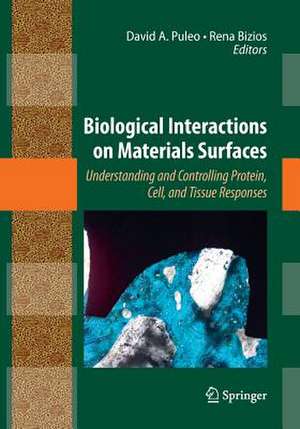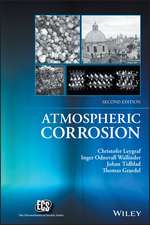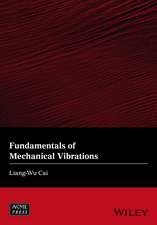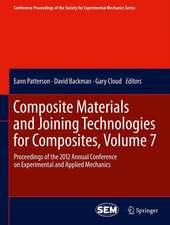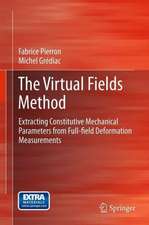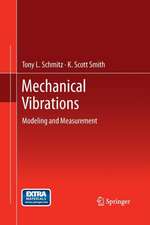Biological Interactions on Materials Surfaces: Understanding and Controlling Protein, Cell, and Tissue Responses
Editat de David A. Puleo, Rena Biziosen Limba Engleză Paperback – 22 aug 2016
| Toate formatele și edițiile | Preț | Express |
|---|---|---|
| Paperback (1) | 956.99 lei 6-8 săpt. | |
| Springer – 22 aug 2016 | 956.99 lei 6-8 săpt. | |
| Hardback (1) | 827.05 lei 38-44 zile | |
| Springer – 26 aug 2009 | 827.05 lei 38-44 zile |
Preț: 956.99 lei
Preț vechi: 1167.06 lei
-18% Nou
Puncte Express: 1435
Preț estimativ în valută:
183.12€ • 191.70$ • 151.52£
183.12€ • 191.70$ • 151.52£
Carte tipărită la comandă
Livrare economică 05-19 aprilie
Preluare comenzi: 021 569.72.76
Specificații
ISBN-13: 9781493939305
ISBN-10: 1493939300
Pagini: 429
Ilustrații: XX, 429 p.
Dimensiuni: 178 x 254 x 29 mm
Greutate: 0.78 kg
Ediția:Softcover reprint of the original 1st ed. 2009
Editura: Springer
Colecția Springer
Locul publicării:New York, NY, United States
ISBN-10: 1493939300
Pagini: 429
Ilustrații: XX, 429 p.
Dimensiuni: 178 x 254 x 29 mm
Greutate: 0.78 kg
Ediția:Softcover reprint of the original 1st ed. 2009
Editura: Springer
Colecția Springer
Locul publicării:New York, NY, United States
Descriere
Success or failure of biomaterials, whether tissue engineered constructs, joint and dental implants, vascular grafts, or heart valves, depends on molecular-level events that determine subsequent responses of cells and tissues. This book presents the latest developments and state-of-the-art knowledge regarding protein, cell, and tissue interactions with both conventional and nanophase materials. Insight into these biomaterial surface interactions will play a critical role in further developments in fields such as tissue engineering, regenerative medicine, and biocompatibility of implanted materials and devices. With chapters written by leaders in their respective fields, this compendium will be the authoritative source of information for scientists, engineers, and medical researchers seeking not only to understand but also to control tissue-biomaterial interactions.
Cuprins
Protein Adsorption to BiomaterialsDavid R. Schmidt, Heather Waldock, and W. John Kao Investigating Protein Adsorption via Spectroscopic EllipsometryMaria F. Mora, Jennifer L. Wehmeyer, Ron Synowicki, and Carlos D. Garcia AFM Methods for Characterizing Protein Interactions with Microphase-Separated Polyurethane BiomaterialsLi-Chong Xu, Pranav Soman, Aashiish Agnihotri, Christopher A. Siedlecki Molecular Simulation of Protein-Surface InteractionsRobert A. Latour Biomolecule-Nanomaterial Interactions: Effect on Biomolecular Structure, Function, and StabilityRavindra C. Pangule, Shyam S. Bale, Dhiral A. Shah, Amit Joshi, Prashanth Asuri, Jonathan S. Dodrick, and Ravi S. Kane Phage Display as a Strategy for Designing Organic/Inorganic BiomaterialsSharon Segvich and David H. Kohn Extracellular Matrix-derived Ligand for Selective Integrin Binding to Control Cell FunctionTimothy A. Petrie and Andrés J. Garcia Ligand-functionalized Biomaterial Surfaces: Controlled Regulation of Signaling Pathways to Direct Cell DifferentiationMyung Hee Kim and Krishnendu Roy Combination of Growth Factors with ScaffoldsYoshiro Ito Cell and Tissue Interactions with Materials: The Role of Growth FactorsChristopher C. Gibson, David A. Puleo and Rena Bizios In Vitro and in Vivo Monocyte, Macrophage, Foreign Body Giant Cell and Lymphocyte Interactions with BiomaterialsJames M. Anderson Development and Differentiation of Neural Stem and Progenitor Cells on Synthetic and Biologically-based SurfacesErin N. Boote Jones, Donald S. Sakaguchi and Surya K. Mallapragada Towards osteogenic differentiation of marrow stromal cellsand in vitro production of mineralized extracellular matrix onto natural scaffoldsAna M. Martins, Catarina M. Alves, Rui L. Reis, Antonios G. Mikos, and F. Kurtis Kasper Biomimetic Nanophase Materials to Promote New Tissue Formation for Tissue Engineering ApplicationsXiaohua Liu, Ian O. Smith and Peter X. Ma Photofunctionalization of Materials to Promote Protein and Cell Interactions for Tissue Engineering ApplicationsShalu Suri, Ankur Singh, and Christine E. Schmidt Hydrogel Nanocomposites in Biology and Medicine: Applications and InteractionsNitin Satarkar, Ashley Hawkins, and J. Zach Hilt Protein and Cell Interactions with Nanophase BiomaterialsCourtney M. Creecy, David A. Puelo, and Rena Bizios Inflammatory Response to Implanted Nanostructured MaterialsKristy M. Ainslie, Rahul G. Thakar, Daniel A. Bernards, and Tejal A. Desai Collagen-I-coated Titanium Surfaces for Bone Implantation Marco Morra, Clara Cassinelli, Giovanna Cascardo, Daniele Bollati Prevention of Post-Surgical AdhesionJohn M. Medley and Thomas D. Dziubla
Notă biografică
Rena Bizios received a B.S. (Cum Laude) degree in Chemical Engineering from the University of Massachusetts, a M.S. degree in Chemical Engineering from the California Institute of Technology, and a Ph.D. degree in Biomedical Engineering from the Massachusetts Institute of Technology. From 1981-2005, she was a member of the faculty in the Department of Biomedical Engineering at Rensselaer Polytechnic Institute, Troy, NY. She is now a Peter T. Flawn Professor in the Department of Biomedical Engineering at the University of Texas at San Antonio (UTSA), San Antonio, TX. During her career, Dr. Bizios has taught various undergraduate and graduate fundamental engineering and biomedical engineering courses as well as developed new courses for biomedical engineering curricula. She has mentored many graduate students, post-doctoral fellows and junior faculty. Most of her former doctoral students are now pursuing academic careers at various universities in the United States.
Her research interests include cellular and tissue engineering, tissue regeneration, biomaterials (including nanostructured ones) and biocompatibility. She has co-authored a textbook (entitled An Introduction to Tissue-Biomaterial Interactions) and authored/co-authored over 95 scientific publications and book chapters. She has given numerous presentations at scientific conferences and invited seminars/lectures in academic institutions and industry. She has also organized and/or co-chaired numerous symposia and sessions at national/international conferences.
Dr. Bizios is a member of many professional societies. She has been an active participant (including elected officer positions) in the Society for Biomaterials, the Biomedical Engineering Society, and the American Institute of Chemical Engineers. She is a member of the editorial board of the Journal of Biomedical Materials Research. She has participated in various (and chaired some) NIH Study Sections, NSF Review Panels, and similar national-level review committees. She has also served on numerous departmental, School/College of Engineering and Institute/University committees at Rensselaer and now at UTSA.
Dr. Bizios received the Outstanding Alumna in Engineering Award of the Society of Women Engineers, College of Engineering, University of Massachusetts, Amherst, MA (1985), the Rensselaer Alumni Association Teaching Award, Rensselaer Polytechnic Institute (1997), and the Clemson Award for Contributions to the Scientific Literature of Biomaterials from the Society for Biomaterials (1998). She was Jubileums Professor at Chalmers University of Technology, Göteborg, Sweden (fall of 2002), Chercheur Associé (spring of 2003) and Directeur de Recherche Associé, Centre National de la Recherche Scientifique, Faculté de Médicine Saint-Louis Lariboisiére, Université Paris VII, Paris, France (fall of 2005). She is Fellow of the American Institute for Medical and Biological Engineering (AIMBE), International Fellow of Biomaterials Science and Engineering of the International Union of Societies for Biomaterials Sciences and Engineering, and Fellow of the Society of Biomedical Engineering (BMES).
David A. Puleo received B.S. and Ph.D. degrees in Biomedical Engineering from Rensselaer Polytechnic Institute. In 1991, he joined the University of Kentucky as a junior faculty member to establish a track in biomaterials in the Center for Biomedical Engineering. In addition to being promoted through the ranks to Professor, he served as Director of Graduate Studies and currently is Director of the Center, overseeing all administrative and educational matters. He also holds an appointment in the Center for Oral Health Research in the College of Dentistry. Dr. Puleo has developed and teaches courses ranging from introductory biomaterials to advanced offerings on events at the tissue-implant interface. He has taught undergraduates, graduates, orthopedic surgery residents, and post-graduate dental students.
Dr. Puleo’s research interests focus on applying understanding of cell-biomaterial interactions to develop materials and surface modification strategies for the purpose of manipulating cellular responses at the tissue-implant interface. He is active in a variety of professional organizations, including the Society For Biomaterials, Biomedical Engineering Society, and the International and American Associations for Dental Research. He is an Assistant Editor for the Journal of Biomedical Materials Research Part B (Applied Biomaterials) and on the editorial board of Journal of Biomedical Materials Research Part A. He has served on and chaired numerous review panels centered on biomaterials and tissue engineering at NIH and NSF and has reviewed for several other domestic and foreign organizations. Dr. Puleo received a Research Initiation Award from the National Science Foundation, was awarded the Bourses de stage de recherche scientifique of the Programme québécois de bourses d'excellence administered through the Ministère de l'Éducation of the Gouvernement du Québec. He is also coauthor of Introduction to Tissue-Biomaterial Interactions, a textbook written specifically for undergraduates and first semester graduate students transitioning into the field of biomaterials
Her research interests include cellular and tissue engineering, tissue regeneration, biomaterials (including nanostructured ones) and biocompatibility. She has co-authored a textbook (entitled An Introduction to Tissue-Biomaterial Interactions) and authored/co-authored over 95 scientific publications and book chapters. She has given numerous presentations at scientific conferences and invited seminars/lectures in academic institutions and industry. She has also organized and/or co-chaired numerous symposia and sessions at national/international conferences.
Dr. Bizios is a member of many professional societies. She has been an active participant (including elected officer positions) in the Society for Biomaterials, the Biomedical Engineering Society, and the American Institute of Chemical Engineers. She is a member of the editorial board of the Journal of Biomedical Materials Research. She has participated in various (and chaired some) NIH Study Sections, NSF Review Panels, and similar national-level review committees. She has also served on numerous departmental, School/College of Engineering and Institute/University committees at Rensselaer and now at UTSA.
Dr. Bizios received the Outstanding Alumna in Engineering Award of the Society of Women Engineers, College of Engineering, University of Massachusetts, Amherst, MA (1985), the Rensselaer Alumni Association Teaching Award, Rensselaer Polytechnic Institute (1997), and the Clemson Award for Contributions to the Scientific Literature of Biomaterials from the Society for Biomaterials (1998). She was Jubileums Professor at Chalmers University of Technology, Göteborg, Sweden (fall of 2002), Chercheur Associé (spring of 2003) and Directeur de Recherche Associé, Centre National de la Recherche Scientifique, Faculté de Médicine Saint-Louis Lariboisiére, Université Paris VII, Paris, France (fall of 2005). She is Fellow of the American Institute for Medical and Biological Engineering (AIMBE), International Fellow of Biomaterials Science and Engineering of the International Union of Societies for Biomaterials Sciences and Engineering, and Fellow of the Society of Biomedical Engineering (BMES).
David A. Puleo received B.S. and Ph.D. degrees in Biomedical Engineering from Rensselaer Polytechnic Institute. In 1991, he joined the University of Kentucky as a junior faculty member to establish a track in biomaterials in the Center for Biomedical Engineering. In addition to being promoted through the ranks to Professor, he served as Director of Graduate Studies and currently is Director of the Center, overseeing all administrative and educational matters. He also holds an appointment in the Center for Oral Health Research in the College of Dentistry. Dr. Puleo has developed and teaches courses ranging from introductory biomaterials to advanced offerings on events at the tissue-implant interface. He has taught undergraduates, graduates, orthopedic surgery residents, and post-graduate dental students.
Dr. Puleo’s research interests focus on applying understanding of cell-biomaterial interactions to develop materials and surface modification strategies for the purpose of manipulating cellular responses at the tissue-implant interface. He is active in a variety of professional organizations, including the Society For Biomaterials, Biomedical Engineering Society, and the International and American Associations for Dental Research. He is an Assistant Editor for the Journal of Biomedical Materials Research Part B (Applied Biomaterials) and on the editorial board of Journal of Biomedical Materials Research Part A. He has served on and chaired numerous review panels centered on biomaterials and tissue engineering at NIH and NSF and has reviewed for several other domestic and foreign organizations. Dr. Puleo received a Research Initiation Award from the National Science Foundation, was awarded the Bourses de stage de recherche scientifique of the Programme québécois de bourses d'excellence administered through the Ministère de l'Éducation of the Gouvernement du Québec. He is also coauthor of Introduction to Tissue-Biomaterial Interactions, a textbook written specifically for undergraduates and first semester graduate students transitioning into the field of biomaterials
Textul de pe ultima copertă
Success or failure of biomaterials, whether tissue engineered constructs, joint and dental implants, vascular grafts, or heart valves, depends on molecular-level events that determine subsequent responses of cells and tissues. This book presents the latest developments and state-of-the-art knowledge regarding protein, cell, and tissue interactions with both conventional and nanophase materials. Insight into these biomaterial surface interactions will play a critical role in further developments in fields such as tissue engineering, regenerative medicine, and biocompatibility of implanted materials and devices. With chapters written by leaders in their respective fields, this compendium will be the authoritative source of information for scientists, engineers, and medical researchers seeking not only to understand but also to control tissue-biomaterial interactions.
Caracteristici
Provides a comprehensive, single source of authoritative information on protein/cell/tissue-biomaterial interactions
Covers both conventional and nanophase materials, including functionalized materials
Includes a variety of cell types and functions
Will appeal to a broad audience with an interest in understanding and controlling surface interactions of biomedical materials
Includes supplementary material: sn.pub/extras
Covers both conventional and nanophase materials, including functionalized materials
Includes a variety of cell types and functions
Will appeal to a broad audience with an interest in understanding and controlling surface interactions of biomedical materials
Includes supplementary material: sn.pub/extras
